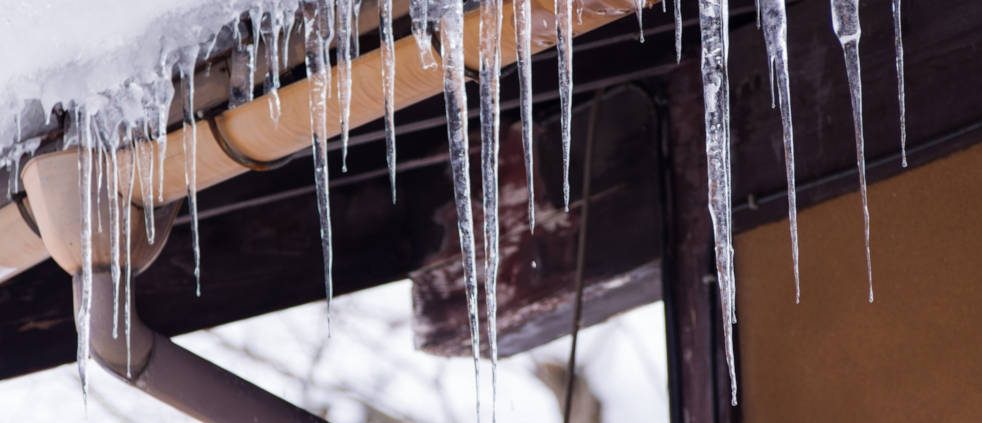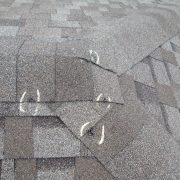Winter’s Toll on Your Roof: Understanding and Preventing Cold Weather Damage
As winter blankets our homes in snow and ice, our roofs silently bear the burden of harsh weather conditions. Understanding how it affects your roof and taking preventive measures can save you from costly repairs and extend your roof’s lifespan.
The Hidden Threats of Winter Weather:
Ice dam formation stands as one of this season’s most destructive forces. These troublesome barriers occur through a simple but damaging process: Heat from your attic melts snow on the roof, which then runs down to the colder eaves. When this water refreezes at the roof’s edge, it creates a barrier that causes subsequent melting water to back up behind it. Eventually, this trapped water seeps under shingles and into your home, causing significant damage.
Snow load stress presents another significant concern for homeowners. While most roofs are engineered to handle typical snow accumulation, excessive buildup can cause structural strain on roof supports, leading to bowing or sagging in roof sections. In severe cases, this weight can even lead to potential collapse, especially on old roofs with granule damage already.
The continuous freeze-thaw cycles throughout winter pose yet another threat. This relentless process can create cracks in roofing materials, expand existing damage, and compromise the integrity of seals around vents and chimneys. Over time, these cycles can loosen shingles and flashing, creating vulnerable points for water infiltration.
Signs of Winter Roof Damage:
Homeowners should remain vigilant for warning signs of damage. Watch for icicles forming along your eaves and water stains appearing on interior ceilings or walls. If you notice sagging areas in your roof, missing or damaged shingles, or experience interior drafts, these could indicate serious problems requiring immediate attention.
Preventive Measures for Winter Protection
Before Winter:
Professional inspection serves as your first line of defense. Schedule a thorough roof examination to address any existing damage, verify flashing and seal integrity, and assess ventilation systems before cold weather arrives.
Proper attic preparation plays a crucial role in winter roof protection. Ensure adequate insulation levels, seal any air leaks, and verify ventilation efficiency. Installing temperature monitoring systems can help you track conditions throughout the season.
During Winter:
Snow management becomes essential during the winter months. Use a roof rake to prevent excessive accumulation, focusing on clearing snow 3-4 feet up from the eaves. Maintaining clear drainage paths helps prevent water backup and ice dam formation.
Professional Solutions:
When winter damage occurs, 1st Choice Construction can provide professional intervention including several approaches. Certified contractors can perform ice dam steam removal, emergency leak repair, and structural reinforcement when needed. Ventilation system upgrades or insulation enhancement may also be recommended to prevent future problems.
Long-Term Protection Strategies:
Consider investing in upgraded insulation with proper R-value for your climate zone, ensuring even distribution and proper vapor barrier installation. Enhanced ventilation through soffit vents, ridge vents, and powered ventilation systems can significantly reduce winter-related issues.
Weather-resistant materials provide another layer of protection. Consider installing ice and water shield, cold-weather rated shingles, and heavy-gauge flashing during your next roof replacement or repair.
Cost-Saving Benefits of Prevention
Taking preventive measures against winter damage offers substantial returns on investment. Beyond reduced energy costs, you’ll benefit from an extended roof lifespan and avoid expensive water damage repairs. Regular maintenance helps maintain your home’s value and prevents costly emergency repairs.
When to Call a Professional
Don’t hesitate to seek professional help from 1st Choice Construction if you notice interior water leaks or hear structural creaking sounds. Large ice dam formations and visible roof damage require immediate attention from qualified contractors who can assess the situation and implement appropriate solutions.
Climate Change Considerations
Today’s changing weather patterns, especially in St. Louis, demand adaptive approaches to roof protection. Consider updating load calculations and enhancing drainage systems to handle more extreme weather events. Regular inspection schedules and flexible maintenance plans help ensure your roof remains resilient despite unpredictable weather patterns.
Winter roof damage doesn’t have to be inevitable. Through proper preparation and maintenance, you can protect your home from winter’s harsh effects. Don’t wait for problems to develop – implement these protective strategies now to ensure your roof remains strong throughout the winter season.
Remember, when in doubt, consult with us to assess your specific situation and provide targeted solutions for your home’s winter protection needs. A small investment in prevention today can save substantial repair costs tomorrow while ensuring your family stays warm and dry throughout the winter months. Don’t hesitate to let 1st Choice Construction protect your roof and home from winter damage.












